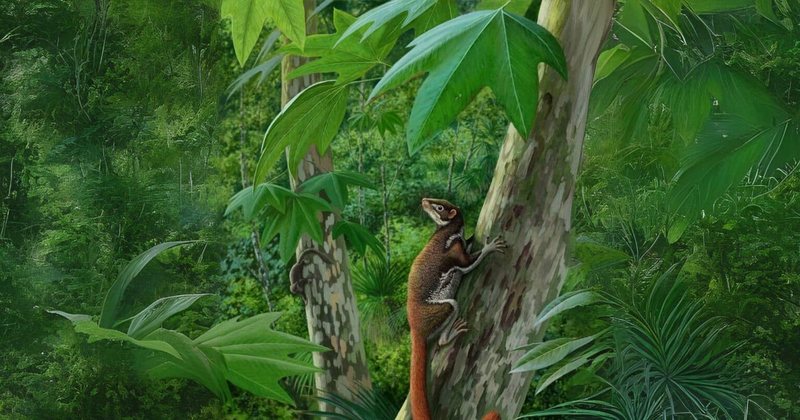
62-million-year-old fossils reshape the history of mammal evolution after dinosaurs


The discovery of the most complete fossil of Mixodectes pungens to date provides key insights into the post-dinosaur diversification of mammals and their evolutionary relationship to primates and humans.
Discovered in New Mexico and dating back about 62 million years, this remarkably preserved skeleton sheds light on how several lineages of mammals adapted to life in the trees after the Cretaceous-Paleogene extinction.
According to a report by Discover Magazine, the fossil's anatomical features — including its climbing adaptations and leaf-based diet — support its placement within a group closely related to modern primates. The discovery offers a rare glimpse into early mammalian ecological and evolutionary experiments.
The partial skeleton, cataloged as NMMNH P-54501, was discovered on the western flank of Torreon Wash, within the Nacimiento Formation of the San Juan Basin, New Mexico. This locality corresponds to the Early Paleocene Tj6 fossil horizon.
Radiometric dating using detrital sanidine gives an estimated age of 62.4 ± 0.03 million years, making it one of the oldest and most complete myxodectid specimens ever found.
The fossil includes a partial skull, a largely preserved axial skeleton, forelimbs, hindlimbs, and features indicative of a mature adult. This is the first specimen of Mixodectes to provide such a detailed anatomical view, enabling a reassessment of the animal's ecological and evolutionary significance.
The skeletal structure of Mixodectes pungens confirms that it was arboreal, adapted to climbing vertical tree trunks. The movable shoulder, rotatable elbow, flexible hips, and long tail (with about 20 caudal vertebrae) suggest a climbing style similar to that of some modern primates.
Dental morphology, including molars suitable for cutting plant matter, indicates an omnivorous diet with a leafy preference. Notably, the newly described skeleton confirms the presence of two upper incisors, providing further support for its placement among euarchonts.
"This fossil skeleton provides new evidence about how placental mammals diversified ecologically after the extinction of the dinosaurs," said Stephen Chester, an associate professor at Brooklyn College and the study's lead author.
Body mass estimates derived from femur measurements place Mixodectes between 1,270 g and 1,370 g (about 2.8–3.0 lb), with a confidence interval ranging from 375 g to nearly 5 kg. This size makes it unusually large for a Paleocene arboreal mammal.
Its larger size and leaf-based diet distinguish it from contemporaries such as Torrejonia wilsoni, which occupied the same habitat but fed mainly on fruit. This divergence in feeding strategy indicates differentiation of ecological zones and reduces direct competition between sympatric species.
Two independent phylogenetic analyses were performed using modified character-taxon matrices. The results consistently place Mixodectes within the primatomorph clade, which includes primates and colugos (Cynocephalus).
Depending on the matrix and constraints used, Mixodectes was found to be either a stem primate or a stem primatomorph, closely related to Microsyops annectens.
"A 62-million-year-old skeleton of this quality and completeness provides new insights into myxodectids, including a much clearer picture of their evolutionary relationships," said Eric Sargis, professor of anthropology at Yale University.
The Paleocene epoch saw mammals diversify rapidly in the wake of the Cretaceous–Paleogene extinction event. Mixodectes appears to have been part of an early arboreal radiation within Euarchonta, exhibiting traits seen later in primates.
The study highlights that Mixodectes likely evolved independently from colugos, despite some dental and postcranial similarities. These features are now interpreted as either parallel adaptations or ancestral traits conserved in both lineages.
"This fossil skeleton provides new evidence about how placental mammals diversified ecologically after the extinction of the dinosaurs," Chester reiterated.
Characteristics such as a larger body mass and an increased reliance on leaves allowed Mixodectes to thrive in the same trees it might have shared with other early primate relatives.
The fossil of Mixodectes pungens represents a critical data point in the evolutionary history of placental mammals.
With its arboreal adaptations, specialized diet, and phylogenetic placement near the base of the primatomorphan tree, it offers a clearer picture of the morphological and ecological experimentation that preceded the rise of true primates – and ultimately, humans.

Rama-Berisha Bazaar, opposite Lulzim Basha!
ideas

It's never been a shame to say "I'm from Bathor"!


Opposition bonus "Berisha" for Edi Rama
top
Alfa recipes
TRENDING 
services
- POLICE129
- STREET POLICE126
- AMBULANCE112
- FIREFIGHTER128























